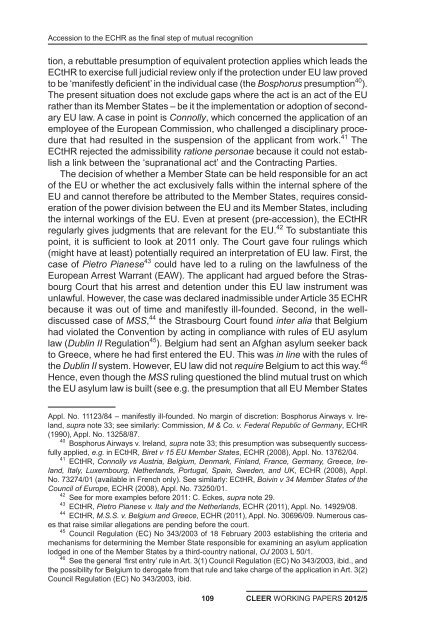CLEER WORKING PAPERS 2012/5Eckesto the ECHR might be the first time for the Court <strong>of</strong> Justice to accept the bindinginternal force <strong>of</strong> the decisions <strong>of</strong> an <strong>external</strong> judicial authority.2.3. Strasbourg Case-Law <strong>and</strong> the European UnionEven before the <strong>EU</strong>’s accession, the judicial bodies <strong>of</strong> the Convention, theCommission <strong>and</strong> the Court, have been concerned with <strong>EU</strong> law numerous times.They have always applied general rules <strong>of</strong> successive treaty accession. Thismeans in principle that in the event <strong>of</strong> a conflict the later treaty prevails (Articles30, 42 <strong>and</strong> 59 Vienna Convention on the Law <strong>of</strong> Treaties (VCLT)). Purelychronologically, the ECHR would be the first treaty for the <strong>EU</strong> Member States<strong>and</strong> the <strong>EU</strong> Treaties would be successive treaties. However, states remainresponsible under the first treaty if the later treaty is concluded between differentparties (‘res inter alias acta’; Article 30(4)(b) VCLT). This appears to be theapproach <strong>of</strong> the ECtHR to <strong>EU</strong> law since it continues to hold the <strong>EU</strong> MemberStates responsible under the ECHR. 34 The Strasbourg bodies have also statedrepeatedly that in conformity with general international law, no action could bebrought against the Union (at the time: the Communities) because it was nota party to the Convention. 35The ECtHR deals implicitly or explicitly with <strong>EU</strong> law more <strong>of</strong>ten than onewould expect. In several cases, it scrutinized <strong>EU</strong> law in surprising detail. 36 Togive the gist <strong>of</strong> the relevant case-law <strong>of</strong> the ECtHR: pre-<strong>EU</strong>-accession MemberStates retain responsibility for their acts, including those adopted within thecontext <strong>of</strong> <strong>EU</strong> law, but acts adopted by the <strong>EU</strong> institutions proper fall outside<strong>of</strong> the ratione personae <strong>of</strong> the Convention. For instance, Member States remainresponsible for primary <strong>EU</strong> law as the consequences <strong>of</strong> a treaty, in the adoption<strong>of</strong> which they have been involved. 37 Yet, the ECtHR has not so far imposed asanction on the <strong>EU</strong> Member States collectively because they remain responsiblefor the international organization to which they have delegated authority,even though it has dealt with a number <strong>of</strong> cases in which such collective responsibilitywas alleged. 38 It is further possible to bring an application againsta (particular) Member State for implementing <strong>EU</strong> law, irrespective <strong>of</strong> whetherthat state had any margin <strong>of</strong> discretion. 39 If the state had no margin <strong>of</strong> discre-Behrami & Behrami v. France, ECHR (2007), Appl. No. 71412/01; ECtHR, Saramati v. France,Germany <strong>and</strong> Norway (GC), ECHR (2007), Appl. Nr. 78166/01, para. 145.34 Commission, Mr X <strong>and</strong> Mrs X v Federal Republic <strong>of</strong> Germany, ECHR (1958), Appl. No.235/56, Yearbook 2, at 256; Commission, Austria v. Italy, ECHR (1961), Appl. No. 788/60, Yearbook4, at 116.35 Commission, Confédération Française Démocratique du Travail v. the European Communities,alternatively: their Member States a) jointly <strong>and</strong> b) severally, Appl. No. 8030/77.36 C. Eckes, supra note 29.37 ECtHR, Matthews v. the United Kingdom, ECHR (1999), Appl. No. 24833/94.38 ECtHR, Soc Guérin Automobiles v 15 <strong>EU</strong> Member States, ECHR (2000), Appl. No.51717/99; ECtHR, Segi ea <strong>and</strong> Gestoras Pro Amnestia v 15 <strong>EU</strong> Member States, ECHR (2002),Appl. No. 6422/02; ECtHR, Senator Lines v 15 <strong>EU</strong> Member States, ECHR (2004), Appl. No.56672/00.39 Wide margin <strong>of</strong> discretion: ECtHR, Cantoni v. France, ECHR (1996), Appl. No. 17862/91– on the merits: no violation; see however: Commission, Etienne Tête v. France, ECHR (1987),108
Accession to the ECHR as the final step <strong>of</strong> mutual recognitiontion, a rebuttable presumption <strong>of</strong> equivalent protection applies which leads theECtHR to exercise full judicial review only if the protection under <strong>EU</strong> law provedto be ‘manifestly deficient’ in the individual case (the Bosphorus presumption 40 ).The present situation does not exclude gaps where the act is an act <strong>of</strong> the <strong>EU</strong>rather than its Member States – be it the implementation or adoption <strong>of</strong> secondary<strong>EU</strong> law. A case in point is Connolly, which concerned the application <strong>of</strong> anemployee <strong>of</strong> the European Commission, who challenged a disciplinary procedurethat had resulted in the suspension <strong>of</strong> the applicant from work. 41 TheECtHR rejected the admissibility ratione personae because it could not establisha link between the ‘supranational act’ <strong>and</strong> the Contracting Parties.The decision <strong>of</strong> whether a Member State can be held responsible for an act<strong>of</strong> the <strong>EU</strong> or whether the act exclusively falls within the internal sphere <strong>of</strong> the<strong>EU</strong> <strong>and</strong> cannot therefore be attributed to the Member States, requires consideration<strong>of</strong> the power division between the <strong>EU</strong> <strong>and</strong> its Member States, includingthe internal workings <strong>of</strong> the <strong>EU</strong>. Even at present (pre-accession), the ECtHRregularly gives judgments that are relevant for the <strong>EU</strong>. 42 To substantiate thispoint, it is sufficient to look at 2011 only. The Court gave four rulings which(might have at least) potentially required an interpretation <strong>of</strong> <strong>EU</strong> law. First, thecase <strong>of</strong> Pietro Pianese 43 could have led to a ruling on the lawfulness <strong>of</strong> theEuropean Arrest Warrant (EAW). The applicant had argued before the StrasbourgCourt that his arrest <strong>and</strong> detention under this <strong>EU</strong> law instrument wasunlawful. However, the case was declared inadmissible under Article 35 ECHRbecause it was out <strong>of</strong> time <strong>and</strong> manifestly ill-founded. Second, in the welldiscussedcase <strong>of</strong> MSS, 44 the Strasbourg Court found inter alia that Belgiumhad violated the Convention by acting in compliance with rules <strong>of</strong> <strong>EU</strong> asylumlaw (Dublin II Regulation 45 ). Belgium had sent an Afghan asylum seeker backto Greece, where he had first entered the <strong>EU</strong>. This was in line with the rules <strong>of</strong>the Dublin II system. However, <strong>EU</strong> law did not require Belgium to act this way. 46Hence, even though the MSS ruling questioned the blind mutual trust on whichthe <strong>EU</strong> asylum law is built (see e.g. the presumption that all <strong>EU</strong> Member StatesAppl. No. 11123/84 – manifestly ill-founded. No margin <strong>of</strong> discretion: Bosphorus Airways v. Irel<strong>and</strong>,supra note 33; see similarly: Commission, M & Co. v. Federal Republic <strong>of</strong> Germany, ECHR(1990), Appl. No. 13258/87.40 Bosphorus Airways v. Irel<strong>and</strong>, supra note 33; this presumption was subsequently successfullyapplied, e.g. in ECtHR, Biret v 15 <strong>EU</strong> Member States, ECHR (2008), Appl. No. 13762/04.41 ECtHR, Connolly vs Austria, Belgium, Denmark, Finl<strong>and</strong>, France, Germany, Greece, Irel<strong>and</strong>,Italy, Luxembourg, Netherl<strong>and</strong>s, Portugal, Spain, Sweden, <strong>and</strong> UK, ECHR (2008), Appl.No. 73274/01 (available in French only). See similarly: ECtHR, Boivin v 34 Member States <strong>of</strong> theCouncil <strong>of</strong> Europe, ECHR (2008), Appl. No. 73250/01.42 See for more examples before 2011: C. Eckes, supra note 29.43 ECtHR, Pietro Pianese v. Italy <strong>and</strong> the Netherl<strong>and</strong>s, ECHR (2011), Appl. No. 14929/08.44 ECtHR, M.S.S. v. Belgium <strong>and</strong> Greece, ECHR (2011), Appl. No. 30696/09. Numerous casesthat raise similar allegations are pending before the court.45 Council Regulation (EC) No 343/2003 <strong>of</strong> 18 February 2003 establishing the criteria <strong>and</strong>mechanisms for determining the Member State responsible for examining an asylum applicationlodged in one <strong>of</strong> the Member States by a third-country national, OJ 2003 L 50/1.46 See the general ‘first entry’ rule in Art. 3(1) Council Regulation (EC) No 343/2003, ibid., <strong>and</strong>the possibility for Belgium to derogate from that rule <strong>and</strong> take charge <strong>of</strong> the application in Art. 3(2)Council Regulation (EC) No 343/2003, ibid.109CLEER WORKING PAPERS 2012/5
- Page 1:
Founded in 2008, the Centre for the
- Page 4 and 5:
CLEER WORKING PAPERS 2012/5Gosalbo
- Page 6 and 7:
CLEER WORKING PAPERS 2012/5Gosalbo
- Page 8 and 9:
CLEER WORKING PAPERS 2012/5Gosalbo
- Page 10 and 11:
CLEER WORKING PAPERS 2012/5Blockman
- Page 12 and 13:
CLEER WORKING PAPERS 2012/5Blockman
- Page 14 and 15:
CLEER WORKING PAPERS 2012/5Casolari
- Page 16 and 17:
CLEER WORKING PAPERS 2012/5Casolari
- Page 18 and 19:
CLEER WORKING PAPERS 2012/5Casolari
- Page 20 and 21:
CLEER WORKING PAPERS 2012/5Casolari
- Page 22 and 23:
CLEER WORKING PAPERS 2012/5Casolari
- Page 24 and 25:
CLEER WORKING PAPERS 2012/5Casolari
- Page 26 and 27:
CLEER WORKING PAPERS 2012/5Casolari
- Page 28 and 29:
CLEER WORKING PAPERS 2012/5Casolari
- Page 30 and 31:
CLEER WORKING PAPERS 2012/5Casolari
- Page 32 and 33:
CLEER WORKING PAPERS 2012/5Casolari
- Page 34 and 35:
CLEER WORKING PAPERS 2012/5Casolari
- Page 36 and 37:
CLEER WORKING PAPERS 2012/5Casolari
- Page 38 and 39:
CLEER WORKING PAPERS 2012/5Casolari
- Page 40 and 41:
CLEER WORKING PAPERS 2012/5Van Elsu
- Page 42 and 43:
CLEER WORKING PAPERS 2012/5Van Elsu
- Page 44 and 45:
CLEER WORKING PAPERS 2012/5Van Elsu
- Page 46 and 47:
CLEER WORKING PAPERS 2012/5Van Elsu
- Page 48 and 49:
CLEER WORKING PAPERS 2012/5Van Elsu
- Page 50 and 51:
CLEER WORKING PAPERS 2012/5Van Elsu
- Page 52 and 53:
CLEER WORKING PAPERS 2012/5Van Elsu
- Page 54 and 55:
CLEER WORKING PAPERS 2012/5Van Elsu
- Page 56 and 57:
CLEER WORKING PAPERS 2012/5Van Elsu
- Page 58 and 59:
CLEER WORKING PAPERS 2012/5Van Elsu
- Page 60 and 61: CLEER WORKING PAPERS 2012/5Van Elsu
- Page 62 and 63: CLEER WORKING PAPERS 2012/5Van Voor
- Page 64 and 65: CLEER WORKING PAPERS 2012/5Van Voor
- Page 66 and 67: CLEER WORKING PAPERS 2012/5Van Voor
- Page 68 and 69: CLEER WORKING PAPERS 2012/5Van Voor
- Page 70 and 71: CLEER WORKING PAPERS 2012/5Van Voor
- Page 72 and 73: CLEER WORKING PAPERS 2012/5Van Voor
- Page 74 and 75: CLEER WORKING PAPERS 2012/5Van Voor
- Page 76 and 77: CLEER WORKING PAPERS 2012/5Van Voor
- Page 78 and 79: CLEER WORKING PAPERS 2012/5Van Voor
- Page 80 and 81: CLEER WORKING PAPERS 2012/5Van Voor
- Page 82 and 83: CLEER WORKING PAPERS 2012/5Van Voor
- Page 84 and 85: CLEER WORKING PAPERS 2012/5Van Voor
- Page 86 and 87: CLEER WORKING PAPERS 2012/5McArdle
- Page 88 and 89: CLEER WORKING PAPERS 2012/5McArdle
- Page 90 and 91: CLEER WORKING PAPERS 2012/5McArdle
- Page 92 and 93: CLEER WORKING PAPERS 2012/5McArdle
- Page 94 and 95: CLEER WORKING PAPERS 2012/5McArdle
- Page 96 and 97: CLEER WORKING PAPERS 2012/5McArdle
- Page 98 and 99: CLEER WORKING PAPERS 2012/5McArdle
- Page 100 and 101: CLEER WORKING PAPERS 2012/5McArdle
- Page 102 and 103: CLEER WORKING PAPERS 2012/5McArdle
- Page 104 and 105: CLEER WORKING PAPERS 2012/5McArdle
- Page 106 and 107: CLEER WORKING PAPERS 2012/5Eckeswit
- Page 108 and 109: CLEER WORKING PAPERS 2012/5Eckesdro
- Page 112 and 113: CLEER WORKING PAPERS 2012/5Eckesare
- Page 114 and 115: CLEER WORKING PAPERS 2012/5EckesEU
- Page 116 and 117: CLEER WORKING PAPERS 2012/5Eckeswil
- Page 118 and 119: CLEER WORKING PAPERS 2012/5EckesPar
- Page 120 and 121: CLEER WORKING PAPERS 2012/5Eckesthe
- Page 122 and 123: CLEER WORKING PAPERS 2012/5Eckesise
- Page 124 and 125: CLEER WORKING PAPERS 2012/5Eckesand
- Page 126 and 127: CLEER WORKING PAPERS 2012/5Eckesto
- Page 128 and 129: CLEER WORKING PAPERS 2012/5Eckesarg
- Page 130 and 131: CLEER WORKING PAPERS 2012/5Wouters,
- Page 132 and 133: CLEER WORKING PAPERS 2012/5Wouters,
- Page 134 and 135: CLEER WORKING PAPERS 2012/5Wouters,
- Page 136 and 137: CLEER WORKING PAPERS 2012/5Wouters,
- Page 138 and 139: CLEER WORKING PAPERS 2012/5Wouters,
- Page 140 and 141: CLEER WORKING PAPERS 2012/5Wouters,
- Page 142 and 143: CLEER WORKING PAPERS 2012/5Wouters,
- Page 144 and 145: CLEER WORKING PAPERS 2012/5Wouters,
- Page 146: CLEER WORKING PAPERS 2012/5Wouters,








